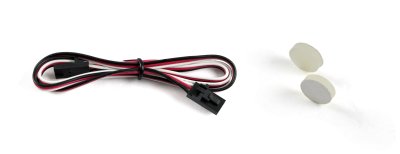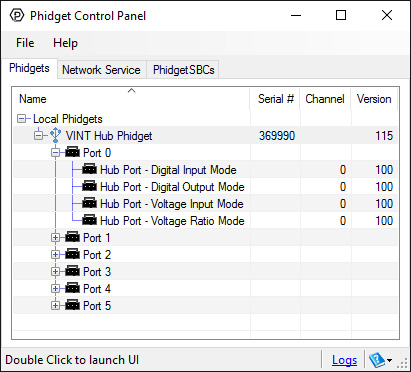The nearest replacement for this product is the 3104_0 - Circular FSR with the 1121_0 adapter.
With its paper-thin construction, flexibility and force measurement ability, the Thin Force sensor can measure force between almost any two surfaces, up to 2 kg.
To ensure the most accuracy, a small disc (included) can be placed directly on the sensing pad before applying force to the disc. This will ensure that all the force is applied directly to the sensing pad and not to the surrounding surface.
Force Sensing Resistors (FSRs) are very thin, robust, polymer thick film (PTF) devices that decrease in resistance when increased pressure is applied to the surface of the sensor. FSRs are not a load cell or strain gauge devices though they have many similar properties.
They are more appropriate for qualitative rather than precision measurements.

This sensor can be read by any Phidget with an Analog Input or VINT Hub port. It will connect to either one using the included Phidget cable. VINT Hub ports can behave just like Analog Inputs, but have the added flexibility of being able to be used as digital inputs, digital outputs, or ports to communicate with VINT devices. For more information about VINT, see the VINT Overview page.
| Product | Voltage Inputs | ||
|---|---|---|---|
| Part Number | Price | Number of Voltage Inputs | Voltage Input Resolution (bits) |
 VINT Hub Phidget
|
$40.00 | 6 (Shared) | *** 15 bit |
 1-Port VINT Hub Phidget
|
$26.00 | 1 (Shared) | ** 16 bit |
 VINT Hub Phidget
|
$35.00 | 6 (Shared) | * 15 bit |
 Wireless VINT Hub
|
$60.00 | 6 (Shared) | * 16 bit |
 PhidgetSBC4
|
$120.00 | 6 (Shared) | * 16 bit |
 PhidgetInterfaceKit 8/8/8
|
$80.00 | 8 | — |
 PhidgetInterfaceKit 2/2/2
|
$50.00 | 2 | 10 bit |
 8x Voltage Input Phidget
|
$20.00 | 8 | 12 bit |
 PhidgetInterfaceKit 8/8/8
|
$80.00 | 8 | 10 bit |
 PhidgetInterfaceKit 8/8/8 Mini-Format
|
$70.00 | 8 | 10 bit |
 PhidgetInterfaceKit 8/8/8 w/6 Port Hub
|
$110.00 | 8 | 10 bit |
 PhidgetTextLCD 20X2 : White : Integrated PhidgetInterfaceKit 8/8/8
|
$70.00 | 8 | 10 bit |
This sensor comes with its own Phidget cable to connect it to an InterfaceKit or Hub, but if you need extras we have a full list down below. You can solder multiple cables together in order to make even longer Phidget cables, but you should be aware of the effects of having long wires in your system.
| Product | Physical Properties | |
|---|---|---|
| Part Number | Price | Cable Length |
 Phidget Cable 10cm
|
$1.50 | 100 mm |
 Phidget Cable 30cm
|
$1.75 | 300 mm |
 Phidget Cable 60cm
|
$2.00 | 600 mm |
 Phidget Cable 60cm
|
$2.00 | 600 mm |
 Phidget Cable 90cm
|
$2.00 | 900 mm |
 Phidget Cable 120cm
|
$2.25 | 1.2 m |
 Phidget Cable 150cm
|
$2.50 | 1.5 m |
 Phidget Cable 180cm
|
$2.75 | 1.8 m |
 Phidget Cable 350cm
|
$3.00 | 3.5 m |
 Phidget Cable Kit
|
$10.00 | 80 mm |
 Phidget Cable Extension Wire 22AWG
|
$0.75/Meter | — |
Welcome to the 1131 user guide! In order to get started, make sure you have the following hardware on hand:
Next, you will need to connect the pieces:

Now that you have everything together, let's start using the 1131!
In order to demonstrate the functionality of the 1131, we will connect it to the HUB0000, and then run an example using the Phidget Control Panel on a Windows machine.
The Phidget Control Panel is available for use on both macOS and Windows machines. If you would like to follow along, first take a look at the getting started guide for your operating system:
Linux users can follow the getting started with Linux guide and continue reading here for more information about the 1131.
After plugging in the 1131 into the HUB0000, and the HUB0000 into your computer, open the Phidget Control Panel. You will see something like this:

The Phidget Control Panel will list all connected Phidgets and associated objects, as well as the following information:
The Phidget Control Panel can also be used to test your device. Double-clicking on an object will open an example.
Double-click on a Voltage Ratio Input object in order to run the example:

General information about the selected object will be displayed at the top of the window. You can also experiment with the following functionality:
The 1131 can handle applied forces of up to 2kg.
The Phidget libraries can automatically convert sensor voltage into force (grams) by selecting the appropriate SensorType. See the Phidget22 API for more details.The Formula to translate voltage ratio from the sensor into a force in grams is:
To ensure the most accuracy, a small disc (included) can be placed directly on the sensing pad before applying force to the disc. This will ensure that all the force is applied directly to the sensing pad and not to the surrounding surface. The longer the object rests on the sensing pad, the more the voltage will drift and increase slowly in value. It is very difficult to compensate for the drift since different constant forces will produce different drift rates. For this reason, the average accuracy of this sensor is within 10% of the true value. The formula above was determined after the object with a known mass was resting on the sensing pad for 15 seconds. The general drift rate curve is logarithmic with time.
matched to the final use conditions. The greater the cycle-to-cycle consistency of these parameters, the greater the device repeatability. In human interface applications where a finger is the mode of actuation, perfect control of these parameters is not generally possible. However, human force sensing is somewhat inaccurate; it is rarely sensitive enough to detect differences of less than ± 50%.
When a repeatable and reproducible system has been established, data from a group of FSR parts can be collected. Test several FSR parts in the system. Record the output voltage at various pre-selected force points throughout the range of interest. Once a family of curves is obtained, a nominal force vs. output voltage curve and the total force accuracy of the system can be determined.
For applications requiring the highest obtainable force accuracy, part calibration will be necessary. Two methods can be utilized: gain and offset trimming, and curve fitting.

The Phidget Cable is a 3-pin, 0.100 inch pitch locking connector. Pictured here is a plug with the connections labelled. The connectors are commonly available - refer to the Analog Input Primer for manufacturer part numbers.
| Sensor Properties | |
|---|---|
| Controlled By | VoltageRatio Input |
| Sensor Type | Force Sensitive Resistor |
| Sensor Output Type | Ratiometric |
| Force Min | 1 N |
| Force Max | 20 N |
| Measurement Error Max | 10 % |
| Electrical Properties | |
| Current Consumption Max | 1.5 mA |
| Output Impedance | 3.3 kΩ |
| Supply Voltage Min | 4.5 V DC |
| Supply Voltage Max | 5.3 V DC |
| Physical Properties | |
| Sensing Area | 126.7 mm² |
| Operating Temperature Min | -30 °C |
| Operating Temperature Max | 70 °C |
| Lifespan | 10 million actuations |
| Customs Information | |
| Canadian HS Export Code | 8473.30.00 |
| American HTS Import Code | 8473.30.11.80 |
| Country of Origin | CN (China) |
| Date | Board Revision | Device Version | Comment |
|---|---|---|---|
| May 2010 | 0 | N/A | Product Release |
This device doesn't have an API of its own. It is controlled by opening a VoltageRatioInput channel on the Phidget that it's connected to. For a list of compatible Phidgets with VoltageRatio Inputs, see the Connection & Compatibility tab.
You can find details for the VoltageRatioInput API on the API tab for the Phidget that this sensor connects to.
| Product | Sensor Properties | Physical Properties | ||||
|---|---|---|---|---|---|---|
| Part Number | Price | Sensor Type | Controlled By | Force Min | Force Max | Sensing Area |
 8″ FlexiForce 0-100lb. Resistive Force Sensor
|
$22.75 | Force Sensitive Resistor | Flexiforce Adapter | 0 N | 444.8 N | 71.3 mm² |
 8″ FlexiForce 0-1lb. Resistive Force Sensor
|
$22.75 | Force Sensitive Resistor | Flexiforce Adatper | 0 N | 4.4 N | 71.3 mm² |
 8″ FlexiForce 0-25lb. Resistive Force Sensor
|
$22.75 | Force Sensitive Resistor | Flexiforce Adapter | 0 N | 111.1 N | 71.3 mm² |
 Interlink Electronics 0.2″ Circular 20N FSR
|
$6.50 | Force Sensitive Resistor | Voltage Divider | 1 N | 20 N | 19.6 mm² |
 Interlink Electronics 0.5″ Circular 20N FSR
|
$7.50 | Force Sensitive Resistor | Voltage Divider | 1 N | 20 N | 126.7 mm² |
 Interlink Electronics 1.5″ Square 20N FSR
|
$10.00 | Force Sensitive Resistor | Voltage Divider | 1 N | 20 N | 14.5 cm² |